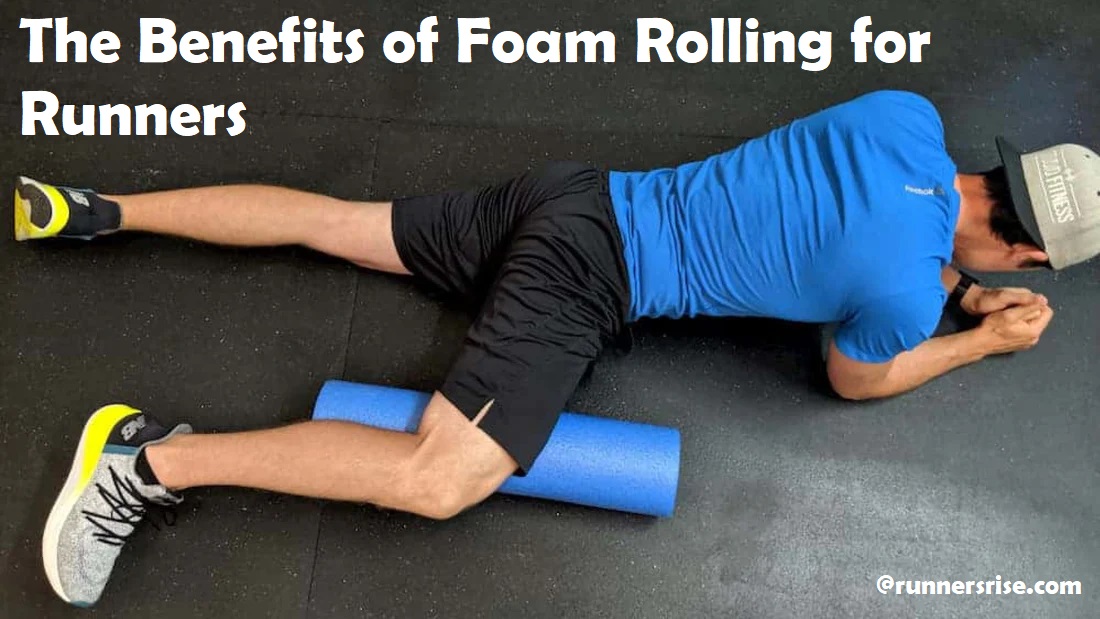Do you dread running due to post-activity soreness? Foam rolling can help!
This complete guide will help you understand how foam rolling can enhance your running experience and reduce the aches that come with it. Ready to learn more about this essential self-care practice for runners? Keep reading!
Foam rolling is becoming increasingly popular among runners, and there are good reasons for it. Foam rolling is a form of self-massage used to increase flexibility and range of motion, reduce soreness, and promote muscle recovery. Considered a form of “self-myofascial release” by medical professionals, foam rolling can be an integral part of any runner’s routine.
This guide provides an overview of the benefits of foam rolling for runners and explains why it’s an important tool for any athlete. We’ll discuss the science behind foam rolling, how to do it safely, and how to use it in conjunction with other recovery activities such as stretching or massage therapy. Finally, we’ll offer some tips on the best practices for incorporating foam rolling into your routine. By the end of this guide, you’ll be better equipped to make sure you’re getting the most out of your foam rolling practice and reaping all the benefits it can provide.
Explanation of foam rolling
Foam rolling is a form of self-myofascial release (MFR), a type of massage. MFR uses stretching and pressure to aid in healing and recovery from sore areas, often due to intense physical activity. Foam rolling is a great way to improve fluidity around your joints and relieve tension throughout your body. It targets the muscles, allowing them to move more freely, leading to improved movement. It helps increase flexibility, alleviate pain, and restore range of motion.
When you foam roll correctly, you can break up the knots in your tissue which can range from minor stiffness to larger knots called “trigger points” that cause pain or impede muscle activation. Through sustained pressure on the knot with a foam roller or cylindrical tool, you can raise its temperature releasing endorphins that act as natural pain relievers in the body’s tissue structures. The act of squeezing helps address negative conditions such as limited range of motion and inflammation. This process increases circulation into the area being treated which helps bring remedial nutrients for faster healing time for both your muscles and connective tissues such as tendons and ligaments.
Understanding Foam Rolling
Foam rolling is a form of self-myofascial release, or SMR. This is a massage technique which helps to break up muscle adhesions, allowing muscles to relax and lengthen. When you roll, you are breaking down the built up toxins in the muscles that are preventing optimal performance and concentration. This process releases endorphins, which is your body’s natural pain reliever and balances muscle tension throughout your body.
SMR can be done with a foam roller or by using other tools such as therapy balls or a massage stick. A foam roller helps runners to loosen up tight muscles and relieve pain from injury and overuse. There are several types of foam rollers available including round, tube-shaped, and grid-like designs, each designed for different purposes and areas of the body depending on your needs.
Foam rolling can be done both pre-run (before exercise)and post-run (after exercise). Before a run it can help warmup muscles for better range of motion during the actual running session which decreases the risk of injuries when putting your body through physical force. After a run it helps improve flexibility and mobility as well as aiding in recovery by redirecting lactic acid build up out of tight muscles back into circulation then allowing restorative blood supplies to enter again into strained muscular tissues while also increasing overall circulation throughout your whole body after running.
What is foam rolling?
Foam rolling is essentially a type of self-massage using a cylindrical foam roller as an aid. It is designed to improve flexibility and mobility while decreasing muscle tightness and soreness. Foam rolling can also improve circulation, help promote relaxation and reduce the risk of injury by releasing tighter muscles and softening scar tissue.
For runners, foam rolling before or after running can help reduce delayed onset muscle soreness (DOMS). DOMS typically occurs within 24 to 48 hours after exercise, when the body attempts to repair microscopic tears in the muscles caused by running. Foam rolling can help reduce DOMS because it helps roll out contracted muscles, relax tense areas and increase joint range of motion—all helping speed recovery time post-workout. Additionally, foam rolling can be used as a form of active rest—a must for runners with tight muscles from overuse.
Benefits of Foam Rolling for Runners
Foam rolling can be a great way to reduce stiffness, improve range of motion, and get relief from pain after running. Foam rolling is a self-massage technique that involves using a foam cylinder to massage tight muscles and break down scar tissue. This can help runners prevent injuries by releasing tension in the muscles, improving circulation and flexibility, and enhancing peak performance.
Foam rolling has been proven to help improve muscular flexibility and reduce muscle stiffness. After exercise, particularly longer sessions of intense running, foam rolling can facilitate faster recovery and enhance muscle recuperation by relieving lactic acid build up in muscles that may lead to discomfort or fatigue. Foam rolling can help runners stretch their muscles more effectively than traditional stretching methods because it encourages changes at the cellular level that affect muscle fibers during activity. It can also improve blood circulation which increases oxygen supply to the muscles leading to improved performance as well as reducing the risk of injury from tension or fatigue.
Furthermore, foam rolling has been known to benefit runners’ mental health by improving overall relaxation before activity and enhancing concentration levels for better endurance during running activities. Studies have indicated that foam rollers may even reduce symptoms like depression due to increased endorphin release from increased blood circulation throughout the body during massage with a foam roller.
Injury Prevention
A great way for runners to avoid injury is foam rolling. Foam rolling is a type of self-myofascial release (SMR) which helps with muscle pain, mobility, mechanical imbalances, inflammation and cramping. This technique helps break down abnormal fascial adhesions or knots and can assist with increased performance in running activities. Foam rolling helps to improve flexibility while also reducing any risk of overuse injuries.
By foam rolling after your running session, you can help prevent yourself from injury as the fascia is dynamized and your soft tissue sensitivity decreases. When performed regularly, foam rolling will reduce long-term effectiveness of imbalances such as any postural issues which could then lead to overcompensations further down the line. Another benefit that comes with regular foam rolling by runners for injury prevention is optimal oxygenation levels within their muscles, which makes foam rolling beneficial for both endurance athletes and racers alike who participate in shorter distances at higher speeds in a shorter period of time.
Reduces muscle soreness and tightness
Foam rolling can help runners reduce muscular tightness and soreness after a race or hard workout. It’s thought to work by releasing the tension that builds up in muscles when running. This “release” of tension is caused by pressure applied to the soft tissue of your muscles which helps to break down any stubborn knots and promotes a better healing process which leads to less soreness and greater mobility.
Foam rolling also helps to alleviate runner’s knee pain due to its ability to target specific muscles and promote increased circulation throughout the region. It also helps reduce fatigue, muscle spasms, and increases flexibility while helping you recover faster from runs or workouts. Foam rolling can be used both before and after running as long as it is used appropriately – making sure not to overdo it – as too much pressure applied at once can cause inflammation in an area that may already be weakened from physical activity.
Using a foam roller on a regular basis can enhance your overall performance with running as well as reduce any potential injuries that may occur due to muscle imbalances. As every runner has unique body requirements, it’s important that you tailor your foam roll sessions accordingly – targeting spots that feel particularly tight or areas prone to injury while avoiding those ones with no pain or discomfort – so you get the most out of each session.
Increases flexibility and range of motion
Foam rolling increases flexibility and range of motion for runners by gradually releasing knots and tightness in the muscles. It helps to break down scar tissue, improve circulation, and restore muscle elasticity which help contribute to faster running times.
By gently rolling the foam roller over tight areas, you stimulate blood flow to those muscles and release tension in them allowing them to move more freely. Foam rolling also gives the muscles a stretch that serves up improved performance. Stretching tissues such as fascia, tendons, facia latae (the thin sheathing of tissue under your skin) can help increase mobility and decrease pain during running. Foam rolling stretches these tissues much differently than traditional stretching because it works by breaking them down while traditional stretching is designed to lengthen them.
Furthermore, foam rolling promotes better nerve function which allows better feedback from your brain to your muscles so that you can perform at peak levels with better coordination. By increasing both strength training (improvement through resistance) coupled with flexibility work– foam rolling is an invaluable asset for runners who want improved performance or simply want to prevent injury.
Improves circulation
Foam rolling is an effective way to improve circulation prior to running and has many other benefits for runners. By gently massaging your muscles, foam rolling helps to bring blood flow to the area, which can help warm up the muscles and ease any soreness or tightness.
Additionally, this increased circulation helps your body become more flexible and better prepared for an intense run. It also helps the body to reduce lactic acid build up from exercise which can cause discomfort after a long run.
The act of foam rolling also helps strengthen the muscles in that area, leading to increased endurance and performance over time as well.
Finally, foam rolling can be beneficial as a recovery tool afterwards by helping flush out toxins while also relaxing muscle tension and tightness so you can return feeling refreshed for your next run.
Conclusion
Foam rolling can be an incredibly beneficial tool for runners of all levels. The increased blood flow and increased range of motion that result can help reduce the risks of injury and keep you running longer, faster and stronger. With a regular program of foam rolling and stretching, you’ll soon start to notice improvements in your endurance, speed and performance.
Although foam rolling may initially be uncomfortable, it quickly begins to feel better with time as the tightness melts away from your muscles. Don’t forget that everyone has different needs when it comes to foam rolling; find what works best for you and stick to it for maximum results.
By fitting foam rolling into your regular routine, you’ll be well on your way to becoming an empowered runner who is ready for any distance!
FAQ’s
Does foam rolling help runners?
Yes, foam rolling can be beneficial for runners as it helps to loosen tight muscles, increase flexibility, and improve circulation.
How often should runners foam roll?
Ideally, runners should foam roll regularly, at least 2-3 times a week. However, the frequency can vary depending on the individual’s needs and preferences.
Is it good to foam roll before running?
Foam rolling before running can be beneficial as it helps to warm up the muscles, increase blood flow, and reduce the risk of injury.
What are 5 benefits of foam rolling?
Some of the benefits of foam rolling include: improving flexibility and range of motion, reducing muscle soreness and tension, increasing blood flow and circulation, promoting relaxation, and aiding in injury prevention.
Is it OK to foam roll every day?
Yes, it is generally safe to foam roll every day, but it’s important to listen to your body and adjust accordingly.
How long should I foam roll?
It’s recommended to foam roll for at least 10-15 minutes, focusing on each muscle group for 30-60 seconds.
Should you drink water after foam rolling?
Yes, it’s important to stay hydrated after foam rolling, as it can be dehydrating and increase the risk of muscle soreness.
When should I not foam roll?
Foam rolling should be avoided if you have an injury or inflammation, or if you experience pain or discomfort while foam rolling.
Is foam rolling better than stretching?
Foam rolling and stretching are both beneficial and can be used together for optimal results. Foam rolling helps to release tension in the muscles, while stretching helps to improve flexibility.
What are 4 benefits of foam rolling?
Some of the benefits of foam rolling include: reducing muscle soreness and stiffness, improving range of motion and flexibility, aiding in injury prevention, and promoting relaxation and stress relief.
See Also-
- Best running shoes for bad knees
- Best running shoes for beginners
- Best running shoes for bunions
- Best running shoes for heavy men
- Best running shoes for kids


